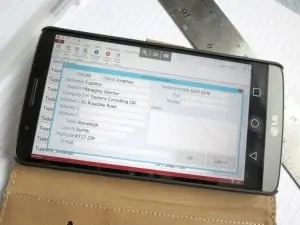As the world becomes more mobile and cloud orientated, I have been working hard trying to get a database to run on a smart phone in some form. Ultimately I’d like to host a database in the cloud and then be able to use Access as an interface not only on a desktop PC but also on a mobile device.
And the news is good – I have finally managed it. (Hurrah!) But it’s been a bit of a journey…
Some time ago I managed to get a database hosted on a cloud service (Microsoft AzureSQL) and connect to it using a regular Access database front end. Even with a slow internet connection, if the database is well designed the performance is pretty good.
To run the database on a phone or tablet however, I wouldn’t be able to use Access. Access requires Windows to run and even a Windows8 phone wouldn’t do because that used a cut down version of Windows8.
So I looked for alternatives – the first thing I turned to was the then new version of Access in Office2013. This had a new feature called WebApps which would allow you to create a database interface using Access that uses the AzureSQL database server. This should have allowed me to run a database in a web browser that I could then run on a phone.
However there were two major drawbacks to WebApps in Access2013. Firstly, they can’t run any code which means they can’t be programmed. Secondly, when you create a WebApp the AzureSQL database is created for you over which you have no control. These things taken together mean that WebApps are, for any real application, completely useless.
The second thing I tried was to program an Android application specifically to run on a phone. I succeeded but it was difficult and time consuming and not really something I could use unless I was going to spend a great deal of time getting good at it.
Then Windows10 was announced. The same version of Windows across all devices – a PC in your pocket that would allow you to do all the things you could do with a desktop machine but on a phone. At this point I thought ‘problem solved’. All I have to do is wait for Windows10 to come along, get a Windows phone, put Access on it and ‘Hey Presto’ – an Access database on a phone.
So I started looking into buying a Windows10 phone to test this out on and I got as far as working out which model would suit. Fortunately, before I bought it I decided to double-check that this would actually work.
It turns out that the notion of a Windows10 PC in your pocket is a myth. A Windows10 phone will only run the mobile versions of the office applications. These mobile versions have no programming capability and there isn’t a version of Access at all. You can already get these mobile applications for Android and Apple phones so there’s actually no advantage whatsoever in having a Windows10 phone.
I actually felt a little embarrassed. I’ve encountered Microsoft’s marketing hype before and I know that not everything turns out the way you might think (see Access2013’s WebApps above). However, I was caught by this. My understanding was that Windows10 was the same operating system on every device and what would run on one would run on them all. I’m sure that I’m not the only person who believed this to be the case.
Obviously I didn’t go ahead and buy a Windows10 phone – what would be the point? So it looked like I was back to the drawing board – either build an entirely web-based database that can be viewed on a phone or build native phone applications.
Then something quite unexpected happened. From time-to-time I get calls from people trying to pick my brains about some aspect of what I do. These usually open by someone sounding like they might be interested in my services so I start answering their questions. However, before long it becomes clear that they don’t want to hire me just get some information. I had just such a call from someone who was looking to get their Access database on-line.
Before I twigged that he was fishing for information we discussed various things and he mentioned a Microsoft Azure service that I’d missed. (Actually missing Microsoft’s Azure services is very easy to do because they seem to breed like rabbits, undergo frequent name changes and come with descriptions so full of buzzwords and jargon that I have no idea what most of them actually do.)
The Azure service I missed was a thing called RemoteApps. This gives you the opportunity to work with a remote service that has the regular Office applications on it. All you need to do is install the client application on your phone and then connect to the remote machine to run your database. Could this be the answer?
So I signed up for a trial of the RemoteApps service and after lots of work (and sadly I do mean lots of work because it wasn’t easy) I linked my Office365 applications to my RemoteApps service and managed to log-on from my phone. Hurrah! – I have an Access database pulling data from my online database with an interface displayed on my mobile phone and it works. It actually bloody works!
All I need to do now is figure out a few tweaks to build an interface that is touch friendly on a tiny phone screen. And the big bonus is that I didn’t have to buy a new phone and I don’t have to persuade a client to buy a new phone either.

